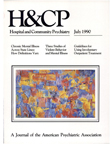Crossing State Lines of Chronic Mental Illness
Abstract
A federal law passed in 1986 required states to develop service plans incorporating each state's own definition of chronic mental illness. This study considered whether the state definitions can be used to identify comparable populations of chronic mentally ill patients and to obtain a meaningful national estimate of the number of such patients. The study applied definitions of chronic mental illness used in ten states to a representative sample of patients receiving public mental health services in West Philadelphia over a two-year period. The prevalence estimates of patients defined as chronically mentally ill ranged from 38 percent using the Hawaii definition to 72 percent using the Ohio definition. The National Institute of Mental Health definition, used as a reference point, produced a prevalence estimate of 55 percent. The authors conclude that the considerable variance among the states in prevalence estimates renders the sum of state counts of chronic mentally ill patients of limited use.
Access content
To read the fulltext, please use one of the options below to sign in or purchase access.- Personal login
- Institutional Login
- Sign in via OpenAthens
- Register for access
-
Please login/register if you wish to pair your device and check access availability.
Not a subscriber?
PsychiatryOnline subscription options offer access to the DSM-5 library, books, journals, CME, and patient resources. This all-in-one virtual library provides psychiatrists and mental health professionals with key resources for diagnosis, treatment, research, and professional development.
Need more help? PsychiatryOnline Customer Service may be reached by emailing [email protected] or by calling 800-368-5777 (in the U.S.) or 703-907-7322 (outside the U.S.).



